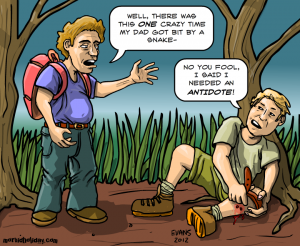 With Phil Stoneman’s helpful anecdotes tips you will never be at a loss for a dinner party story or a funny tale to break the ice
With Phil Stoneman’s helpful anecdotes tips you will never be at a loss for a dinner party story or a funny tale to break the ice
Anecdotes can have a bad reputation – sometimes because they seem trivial, and other times because they distract us from important information.
They are, however, an essential part of human interaction. When primitive humans first met around their fires, stories were what inspired them and helped them to understand what it meant to be human. Instead of disappearing, they’re still massively important. In job interviews, for example, people are regularly asked to describe a time when they solved a problem; at business events, the sales agent who can’t tell a story to break the ice will have a difficult time with his/her customers. Many foreign language exam systems also have a part where you have to speak about something personal.
Given how important anecdotes are, you need to know how to tell one. Here is some useful advice to make yourself into the story master:
What’s the story?
As Steve Martin says in the movie Planes, Trains and Automobiles, “You know when you’re telling these little stories? Here’s a good idea – have a point. It makes it so much more interesting for the listener!” So be very clear when you’re telling an anecdote: what’s your message? What do you want to express? Anecdotes aren’t supposed to be the biggest, most life-changing events in the history of the world, but you have to give your listener a reason to listen to you. Also, remember that you know the anecdote, but your listener doesn’t – not yet, anyway. So help your listener, and include all the information they will need. And keep it short! The space between not giving enough information and giving too much can be hard to find, but it’s an essential element of good story telling.
Choose your style
Once you’ve decided what you’re going to say, it’s time to think about how to say it. Again, this is connected to the content of your anecdote. Think about what effect you want to have on your audience: surprise them? Make them laugh? Or cry? Whatever your intention is, it’s how you tell the anecdote that makes all the difference.
Look at these two examples:
a) Yesterday I walked out of my house but I couldn’t find a taxi.
b) Yesterday I was looking for a taxi for so long, but I couldn’t find one anywhere! It was very frustrating because I had to get to the university!
Adjectives can help a lot with this, especially emotive ones that connect your listener with what you were feeling at the time.
Get yourself connected
A key part of helping your listener to follow your story is to guide them with connectors. These include common words like and and but, as well as special phrases that are particularly helpful to guide your listener. These words are like signs that show what’s happening, and what’s going to happen next. So to show your listener that something surprising is going to happen, use phrases like: to my surprise, the amazing thing was, or what I didn’t know was.
Embrace the past
Unless you live a particularly exciting life, your anecdotes probably happen in the past. This means that you have to use past tenses to tell your story. This doesn’t mean that you must include a whole range of different tenses: you can tell a great story using mostly past simple with a bit of past continuous. What you do need to be careful of is being consistent – don’t start with past simple, then switch to present simple, then go back to past simple.
-ed endings: how to say them!
Did you know that there are three different ways to pronounce -ed endings in English? We use these all the time, for past tenses, adjectives and passive voice, so it’s important to learn the difference:
1. When the verb ends with a ‘t’ or ‘d’ sound, we make a new syllable at the end and the -ed is pronounced like ‘id’. Some verbs in this category are wait, expect, and decide.
2. When the verb ends with a voiced sound, the -ed sounds like ‘d’ without making a new syllable. A voiced sound is one where you make a little vibration – to check, put your fingers on the front of your neck, like in the drawing. Now say love, play and call – that vibration you feel at the end of the word means that it’s a voiced sound.
3. For verbs ending in ALL other sounds, the -ed is pronounced like ‘t’, again without making a new syllable. For example, the past simple tense of like, watch and kiss are pronounced in this way.
The truth is that there isn’t a big difference between the sounds we use for the verbs in groups 2 and 3, but if you get these verbs confused with the ones from group 1, it can b very hard for people to understand you.
Watch your words
When you’re speaking, you want your anecdote to be as easy as possible to understand. This means pronouncing -ed endings in the right way (see the -ed endings: how to say them box) and emphasising which things are important. When we speak in English, some words are weak and others are strong, and it’s only when you can hear the difference that your own speech will sound more natural.
Practice makes perfect
You might be naturally great at telling anecdotes, but for most of us, that only comes with practise. The good news is that this is easy to do with any phone that has a microphone – record yourself telling an anecdote, then listen to your recording. Is it all perfectly clear, or is there anything you could do better? Try to identify how you can improve, and then record yourself again.
Being able to tell an anecdote is an important skill to have, and you don’t have to feel nervous about it! Try it out, and you’ll soon be an expert storyteller.
Related: English language puns
Five steps to a good anecdote1. Give your story a title 2. Write at least 4 paragraphs – Arouse interest 3. Use past continuous for background information It was raining heavily as we left the house 4. Use past perfect before the main events of the story …but Anne had kindly lent me her umbrella 5. Use simple past for main events There wasn’t a single person on the street Don’t forget to use time conjunctions like while, by the time… |
Originally from Sheffield, England, Phil Stoneman has been teaching English in Colombia for over twelve years. He enjoys seeing his students develop their abilities and become independent language learners.













